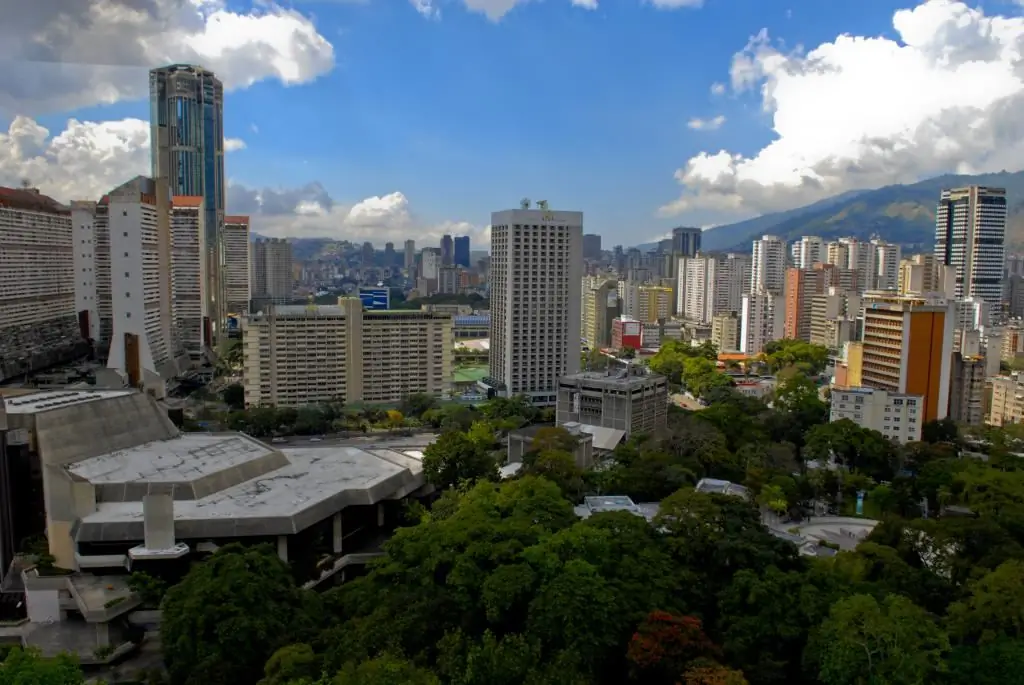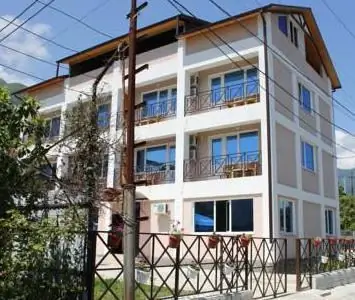- Author Harold Hamphrey [email protected].
- Public 2023-12-17 10:06.
- Last modified 2025-01-24 11:10.
For more than 20 years, Turkey has been a confident leader among tourist destinations around the world. The Mediterranean coast of the country is mainly in demand, although in recent years the Aegean Sea has also become a favorite of numerous travelers. Beach holidays in Turkey are really great, but few people know about the alternative pastime here. But just 120 km from the Aegean coast, at the northern foot of Mount Karji, there is a real crossroads of times - the city of Denizli. Here, in the most bizarre way, antiquity in the face of historical monuments is intertwined with modern civilization and oriental flavor in a close embrace. And besides excursions, the city will gladly offer you a spa-style vacation - mineral springs, thermal pools, traditional hamams will not leave anyone indifferent. But its main pearl lurks 18 km to the north.

How to get there?
Only 15 minutes by car along the excellent Antalya-Izmir highway, surrounded by picturesque mountains and cliffs, and welcome to a new wonder of nature, Pamukkale. A truly stunning picture will appear before your eyes - a snow-white mountain with flowing turquoise streams of thermal waters against an azure sky! Almost every tourist guide says about Pamukkale that this is one of the most popular attractions in Turkey. Indeed, the so-called Cotton Castle impresses with its natural, miraculous beauty.
Pamukkale - what is it?
First of all, Pamukkale, reviews of which are so enthusiastic, is a huge thermal pool of natural origin. In spring, hot jets of highly calcined mineral water cascade down from the bowels of the earth. Evaporating, the water leaves on its way whimsically frozen calcium crystals of a dazzling white color.

Pamukkale travertines are capable of envying even the most talented and skillful architect. And since there are a lot of thermal springs in the vicinity, this area has also become famous as a spa resort.
Why "Cotton Castle"?
Absolutely in all guidebooks, Pamukkale is also called the Cotton Castle, because this is how this word is translated from Turkish. The mountain owes this name, firstly, to its snow-white shade, and secondly, to the history of the nearby town of Denizli. Denizli has long been famous for its cotton,which was grown there for the needs of the whole country, and even for export.
History of Pamukkale
Pamukkale has been known since ancient times as a unique thermal spa resort. That is why the ancient city of Hierapolis is located nearby. The Romans built it in close proximity to a hot mineral spring. The ancient thermal pool of Hierapolis still exists, surrounded by the skeletons of marble columns and the ruins of the ancient Roman temple of Apollo.

The temperature of the water here is approximately equal to the temperature of the human body (35-36 ° C), so you will not be able to refresh yourself. Lush greenery around the perimeter creates a pleasant shade and coolness. The dimensions of the pool allow up to 200 people to be in it at the same time so that they do not interfere with each other. In addition, the pool is divided into two parts - shallow and deeper. Locals tell legends that Cleopatra herself has been here more than once and enjoyed immersing herself in the healing waters of the mineral spring. By the way, you can follow the example of the queen and plunge into the pool, of course, not for free. It costs about 30 Turkish liras to visit.
Pamukkale - excursion or independent travel?
What to prefer in this case? Where Pamukkale is located on the map, almost every tourist knows. You can get here by private car, bus, train or plane. For example, traveling from Antalya or Marmaris to Izmir, Ephesus or Kusadasi, you can stay overnight in Pamukkale. The hotels here are veryvaried both in terms of pricing policy and the level of service. Alternatively, you can go to Pamukkale on a day trip from Ephesus or Izmir.

But even if you are not a fan of independent travel, you can still visit Pamukkale. An excursion here is organized from almost anywhere in Turkey, and even the longest trip will be easy and comfortable thanks to local buses and the quality of Turkish routes. The distance to Pamukkale from any popular beach resort is no more than 300-350 km. Depending on the direction, you can drive along a breathtaking mountain serpentine or along a pleasant and easy course of a calm river. An excursion to Pamukkale from Kemer or Antalya should optimally be two days, combining Pamukkale and Ephesus. Here you will spend an enjoyable day exploring the vast ancient Roman ruins of Hierapolis, visit the largest ancient amphitheater, see the exhibits in the Archaeological Museum, take pictures at the picturesque travertines and cool off in the Cleopatra Pool. In addition, a visit to Pamukkale can be combined with Laodocia or the city of Aphrodite, the goddess of love.
Pamukkale surroundings
Almost all tourists who have visited Turkey at least once heard about Pamukkale, that it is the most beautiful Cotton Castle. But few people know how many more beauties are hidden in its surroundings. Laodokia is located just two kilometers west of the Denizli-Pamukkale road. Give this ancient town at least a couple of hours - you will not regret it. If you plan to dedicate to walks in the neighborhooda few days, we recommend staying in the town of Pamukkale - there are nice hotels here, each of which, by the way, has its own thermal pool. There are more than 30 of them in total. Hal-Tur Hotel, Venus Hotel, Sinter Terasse House Hotel, Melrose Viewpoint Hotel, Ozbay Hotel received the highest ratings from tourists.

Pamukkale Plateau
As we have already said, Pamukkale is a small, only 300 m high, mountain with a plateau on top, where the ruins of Hierapolis and Cleopatra's pool are located. There are only three roads leading to the plateau, on each of which you will have to pay an entrance fee. It is optimal to rise and fall from different sides in order to fully appreciate the beauty of Pamukkale. The tour will cost you an average of $10.
Interesting fact about Pamukkale
In the early 90s of the previous century, local authorities decided to change the development strategy of the Pamukkale resort in order to increase the flow of tourists from abroad. But as a result of an incorrectly developed strategy, the number of tourists, on the contrary, decreased, so until the beginning of the 21st century, almost nothing was said about Pamukkale in tourist guides.
Tourist Tips
If you decide to go on an independent trip and explore Pamukkale without the help of a guide, the following recommendations will be useful to you. If you enter the city by private car, you can see that the locals on motor scooters around you are actively gesturing and trying in every possible way to attract your attention. The first thought that comes to minda gullible tourist is a doubt: maybe something is wrong with the car? In fact, as soon as you stop and get out of the car, the locals will immediately try to put some nonsense into your hands and begin to persuade you to buy it. They will ask if you need a hotel, a restaurant or a souvenir shop, and if necessary, they will certainly guide you to your destination, for which, of course, they will take their “commission”. Whether this will affect the price you pay is unknown, but it certainly won't go any lower!

Prohibitions
As a UNESCO World Heritage Site, Pamukkale is protected by local and international law. Thus, the road leading to the terraces from the southeast is closed to visitors. The hiking trail is marked and limited here, and the entrance to the terraces is prohibited in order to preserve the flow of water, the color and structure of the travertines. Separately installed and marked places where visitors can swim in the thermal waters.
Reviews and opinions of tourists
Most of those who visit this wonderful creation of nature are indescribably delighted - you seem to find yourself in a parallel reality, tourists say. In fact, the Cotton Castle really makes a lasting impression. Snow-white terraces, turquoise water, ancient architectural monuments, relaxed atmosphere will appeal to everyone, regardless of gender, age and nationality.
This place is exceptional for the uniqueness of natural phenomena: warm, highly mineralized water gushing from thermal springs andflowing down the snow-white slopes of the mountain, forms crystal clear turquoise pools. The plateau that crowns this natural wonder features the oldest example of early Christian architecture in the Roman style.

Pamukkale National Park, reviews of which are usually enthusiastic, combines not only the famous Cotton Castle, but also several adjacent villages, near which thermal springs come to the surface. And in the local ancient amphitheater in Hierapolis, modern theater troupes still perform, taking us back many centuries and surprising us with excellent acoustics and a stunning atmosphere.
Pamukkale National Park is truly a masterpiece created by nature, and a pearl not only of Turkey, but of the whole world!






